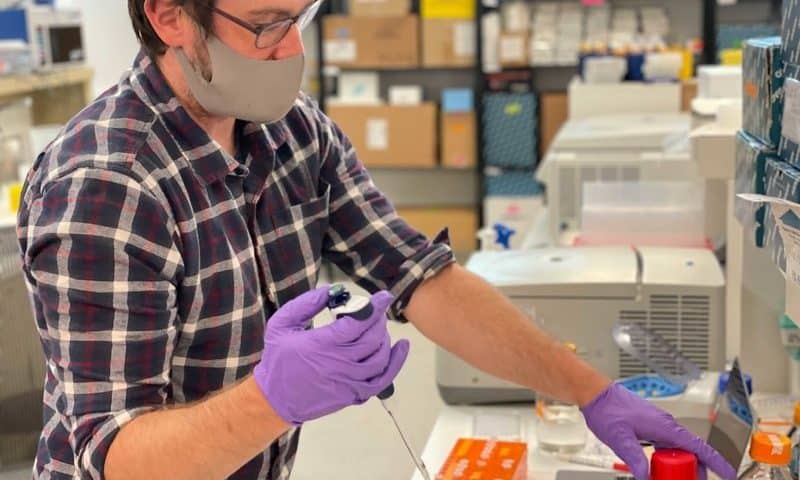Proteins that switch genes on and off are some of the most important drug targets—and also some of the oldest, according to Alex Federation, Ph.D., co-founder and CEO of Talus Bio.
Think androgen receptors, the target of many prostate cancer drugs; estrogen receptors, targeted by breast cancer meds; and glucocorticoid receptors, the target of dexamethasone and other steroid medications.
But these receptor proteins are the exception rather than the rule. They represent the “super low-hanging fruit,” the small proportion of gene regulatory proteins, or GRPs, that have evolved to be easy to drug.
“They’ve evolved to bind small molecules and turn genes on and off,” Federation said.
Other gene regulatory proteins, such as transcription factors and histones are far trickier and have largely eluded drug development efforts.
“The rest are very rigid intertwined proteins that stick to DNA and there’s no spot on them to put a small molecule when they are in the cell,” Federation said.
With its first focus in oncology, Talus Bio is looking to drug these difficult targets by knocking them off of DNA, effectively switching off disease-causing genes.
It might find that established approaches such as small molecule inhibitors could do the trick, and that old drugs could be repurposed. Or it could determine that new technologies such as small molecule degraders, molecular glues or covalent inhibitors are in order. But what makes it all possible are new techniques developed by Lindsay Pino, Ph.D., co-founder and chief technology officer of Talus.
As a post-doctoral researcher, Pino was focused on using mass spectrometry to measure proteins, but in a philosophical way. Federation, with whom Pino had collaborated before, arrived in her lab with a more practical application.
“He had all these proteins in test tubes but no way of measuring them,” Pino said. She then figured out how to measure proteins interacting with DNA inside the cell’s nucleus and not the proteins floating around in the cell’s cytosol.
Researchers have tried to pull gene regulatory proteins out of engineered human cells or bacteria and purify them to study in test tubes. But unlike other drug targets such as kinase enzymes, which work just fine in a test tube, many gene regulatory proteins have unstable structures and fall apart when they’re taken out of the cell. That’s because the purification process gets rid of DNA and other proteins that help stabilize them.
Others have attacked the problem from the DNA side, capitalizing on the rising accessibility and decreasing costs of genome sequencing. They pick a protein and try to figure out which genes it switches on and off. But this still puts proteins in an artificial environment, making things a lot more complicated than they need to be.
Talus wants to keep things simple.
Instead of removing transcription factors from their native environment where they are stable and function properly, the company is bringing drug discovery to the cell itself.
After treating the cell with a potential drug, Talus uses its platform, dubbed MARMOT to get rid of everything in the cell that isn’t stuck to the DNA, Federation said. That leaves behind a trove of potential drug targets for analysis.

From there, the cell goes to the mass spectrometer, which measures the amount of all the proteins that are stuck to the DNA. Because the mass spectrometry data are so dense, Talus has a team of computer scientists and machine-learning engineers to “deconvolute” them.
“Genes have switches… We measure which of the switches are on or off. We can discover a new switch and measure if it’s on or off. We can measure how powerful they are. Are there a lot of them or just one or two? We get the entire regulatory ‘switchscape,’” Pino said.
Talus will use this information to identify and develop drugs that target gene regulatory proteins. And because the technology scoops up every GRP in the cell—even the ones the company isn’t interested in—Talus can come back to the data later to find answers to questions it didn’t know to ask in the first place.
“We’re not trapped by when we collected these data and only asked for things we already knew,” Pino said.
Though Talus eventually wants to develop its own pipeline of drugs, it is starting with partnerships with pharma companies and research institutions. It hopes to stress-test its platform with partners that have more advanced molecules and aren’t starting from scratch.
“Based on what we learn from that, we’ll be starting to spin out our own programs over the next few months to next year,” Federation said.
Talus spun out of the University of Washington and Seattle’s Altius Institute for Biomedical Sciences in October 2020 and raised a pre-seed round of $1.5 million. It picked up another $125,000 in seed funding from Y Combinator and stands to raise more after pitching its work to investors at the accelerator’s Demo Day at the end of August.
Its first focus will be small molecule drugs for cancer treatment, but Federation and Pino envision many uses for its approach, including aging.
“When we are born, we have a set genome and as time goes on, we gain some mutations to the genome,” Pino said. “But really, we don’t age because the genome is changing, we age because the nuclear organizational factors are changing. Some are switched on and some are switched off, and DNA gets poorly organized over time.”
The company could come up with drugs that toggle those switches, making them “more appropriately turned on and off,” Pino said. It’s a compelling area because “aging is comorbid with everything.
“The risk of cancer increases with aging. The risk of cardiovascular disease increases with aging,” Pino said. “If we can find some of these switches that are losing their power over time because the DNA isn’t organized correctly, we can come up with therapies that can augment cancer or cardiovascular therapies. We imagine that would be something really powerful in a lot of indications.”

